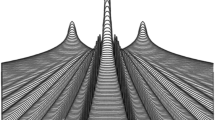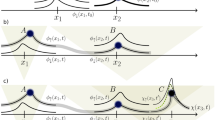Abstract
It’s generally taken to be established that no local hidden-variable theory is possible. That conclusion applies if our world is a thread, where a thread is a world where particles follow trajectories, as in Pilot-Wave theory. But if our world is taken to be a set of threads locality can be recovered. Our world can be described by a many-threads theory, as defined by Jeffrey Barrett in the opening quote. Particles don’t follow trajectories because a particle in our world is a set of elemental particles following different trajectories, each in a thread. The “elements” of a superposition are construed as subsets in such a way that a particle in our world only has definite position if all its set-theoretic elements are at corresponding positions in each thread. Wavefunction becomes a 3D density distribution of particles’ subset measures, the stuff of an electron’s “probability cloud”. Current Pilot-Wave theory provides a non-relativistic dynamics for the elemental particles (approximated by Many Interacting Worlds theory). EPR-Bell nonlocality doesn’t apply because the relevant measurement outcomes in the absolute elsewhere of an observer are always in superposition.
Similar content being viewed by others
Notes
As described by AntonyValentini [3, pp. 498–499].
For some discussion of unusual cases see [19, p. §5].
For a succinct account see [18, pp. 29–34].
Quoted in [10, p. 10].
The term ‘Quine atom’ is sometimes used simply to denote a set which is its own sole element. I use the term ‘Quineian individual’ for objects characterized as in the quote.
See [26, p. §10] for some discussion of this type of approach to quantum theory.
Hall, Deckert and Wiseman write:
The MIW [Many Interacting Worlds] approach can only become equivalent to standard quantum dynamics in the continuum limit, where the number of worlds becomes uncountably infinite. [26, p. §1].
Sebens argues that finitude is called for because the intelligibility of a subject’s assignment of probabilities to alternative futures is based on ‘self-locating uncertainty’ which requires a ‘basic indifference principle’ [25, p. 282], original emphasis.
In [8, p. 6390] it’s suggested that a version of the Principle Principle might be justified via the Deutsch-Wallace theorem.
References
Bell, J.S.: Speakable and unspeakable in quantum mechanics. CUP, Cambridge (1987)
Barrett, J.A.: The quantum mechanics of minds and worlds. Oxford University Press, Oxford (1999)
Valentini, A.: De Broglie-Bohm Pilot-Wave theory: many worlds in denial? In: Saunders, S., Barrett, J., Kent, A., Wallace, D. (eds.) Many Worlds? Everett, quantum theory, and reality, pp. 476–509. Oxford University Press, Oxford (2010)
Saunders, S.: Chance in the Everett interpretation. In: Saunders, S., Barrett, J., Kent, A., Wallace, D. (eds.) Many Worlds? Everett, quantum theory, and reality, pp. 181–205. Oxford University Press, Oxford (2010)
Wilson, A.: Objective probability in Everettian quantum mechanics. Br. J. Philos. Sci. 64, 709–737 (2013)
Wilson, A.: The nature of contingency: quantum physics as modal realism. Oxford University Press, Oxford (2020)
Lewis, D.K.: A subjectivist’s guide to objective chance. In: Jeffrey, R.C. (ed.) Studies in inductive logic and probability, vol. 2, pp. 263–293. University of California Press, Berkeley (1980)
Tappenden, P.: Everettian theory as pure wave mechanics plus a no-collapse probability postulate. Synthese 198, 6375–6402 (2021)
Barrett, J.A.: Situated observation in Bohmian mechanics. Stud. Hist. Philos. Sci. (2021). https://doi.org/10.1016/j.shpsa.2021.06.009
Tappenden, P.: Objective probability and the mind-body relation. Stud. Hist. Philos. Mod. Phys. 57, 8–16 (2017)
Tegmark, M.: The multiverse hierarchy. In: Carr, B. (ed.) Universe or Multiverse? Cambridge University Press, Cambridge (2007)
Everett, H., III.: “Relative state” formulation of quantum mechanics. Rev. Mod. Phys. 29, 454 (1957)
Barrett, A., Byrne, P. (eds.): The Everett Interpretation of Quantum Mechanics. Princeton University Press, Princeton (2012)
Sider, T.: All the World’s a stage. Australas. J. Philos. 74, 433–453 (1996)
Parfit, D.: Reasons and persons. Oxford University Press, Oxford (1984)
Sider, T.: Four dimensionalism. Oxford University Press, Oxford (2001)
Pashby, T.: ‘How Do Things Persist? Location relations in physics and the metaphysics of persistence. Dialectica 70, 269–309 (2016)
Maudlin, T.: Philosophy of physics: quantum theory. Princeton University Press, Princeton (2019)
Tappenden, P.: Evidence and uncertainty in Everett’s Multiverse. Br. J. Philos. Sci. 62, 99–123 (2011)
Quine, W.V.O.: Set theory and its logic. Harvard University Press, Cambridge (1969)
Tappenden, P.: Identity and probability in Everett’s Multiverse. Br. J. Philos. Sci. 51, 99–114 (2000)
Lockwood, M.: Mind, brain & the quantum. Blackwell, Oxford (1989)
Lewis, D.K.: Parts of classes. Blackwell, Oxford (1991)
Hall, M.J.W., Deckert, D.A., Wiseman, H.M.: Quantum phenomena modelled by interactions between many classical worlds. Physics Review X 4, 041013 (2014)
Sebens, C.T.: Quantum mechanics as classical physics. Philos. Sci. 82, 266–291 (2015)
Vaidman, L.: Quantum theory and determinism. Quantum Stud 1, 5–38 (2014)
Acknowledgements
I particularly want to thank Simon Saunders for a careful reading of an earlier draft which revealed a crucial error. Also a reviewer who encouraged me to say more about the details of the metaphysics and indicated a number of issues in need of resolution.
Author information
Authors and Affiliations
Corresponding author
Ethics declarations
Conflict of interest
I declare that I have no conflicting interests.
Additional information
Publisher's Note
Springer Nature remains neutral with regard to jurisdictional claims in published maps and institutional affiliations.
Rights and permissions
Springer Nature or its licensor holds exclusive rights to this article under a publishing agreement with the author(s) or other rightsholder(s); author self-archiving of the accepted manuscript version of this article is solely governed by the terms of such publishing agreement and applicable law.
About this article
Cite this article
Tappenden, P. Pilot-Wave Theory Without Nonlocality. Found Phys 52, 107 (2022). https://doi.org/10.1007/s10701-022-00627-0
Received:
Accepted:
Published:
DOI: https://doi.org/10.1007/s10701-022-00627-0




